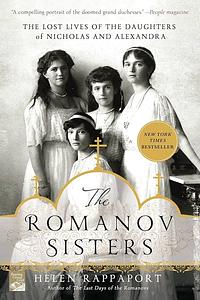Take a photo of a barcode or cover
So many of the books I have read on the Romanovs gloss over Olga, Tatiana, Maria and Anastasia, especially after Alexey is born. This book does a great job of bringing these young women to life.
emotional
sad
tense
fast-paced
she’s done what i’ve been longing for historians to do for ages now: humanise the girls. they come off as real people here, which is really compounded by the fact that they were raised so differently from how you’d expect the children of the richest man in the world to be raised. i walked away knowing each sister as an individual, not just a section of OTMA, and i savoured every little tidbit of personhood the author managed to capture. she took such great care to mold the romanov girls’ characters out of nothing but scraps, even going as far as to sketch out the psychology of their parents. i have a special love for tatiana, the sister i relate to the most.
I have been intrigued by these sisters with the little knowledge I knew about the Romanov family. This book is not really about the four sisters but the entire family and their life at court leading up to their death. Having daughters I find it very fascinating that they were secluded from society as a whole despite the fact that they were royalty. I loved the insight on their religious faith. This perspective, to me, was the most interesting part of this book. The whole family has amazing faith. The father Nicolas says "it is not evil that will conquer evil- only love." I loved the letters in this book and loved the perspective those actual conversations give you on their life. This is not a book for the light hearted. I love biographies and found this very interesting although it was a heavy read. A little bit of a misleading title but I understand that you cannot tell the Romanov sisters' stories without telling the whole family's story.
Check out the full review at Kritters Ramblings
The Romanov family may be one of the most famous families in history, but I always wondered if all the stories I had heard about them were anywhere near the truth. I was intrigued by this book when I received the pitch and was excited to see a bibliography that was many many pages knowing that this author sought out the truth to write her book.
With a few stories in a history class and a Disney movie, I knew that the little "facts" that I had from their history could be a little off. I knew of Rasputin and knew of the finale, but didn't know how Rasputin was involved in the downfall of their family.
The Romanov family may be one of the most famous families in history, but I always wondered if all the stories I had heard about them were anywhere near the truth. I was intrigued by this book when I received the pitch and was excited to see a bibliography that was many many pages knowing that this author sought out the truth to write her book.
With a few stories in a history class and a Disney movie, I knew that the little "facts" that I had from their history could be a little off. I knew of Rasputin and knew of the finale, but didn't know how Rasputin was involved in the downfall of their family.
Two years ago I went to Russia and I wish I had read this book before. It would have put somethings in perspective while I was in St. Petersbourg and Peterhof. This book is well researched and provides great insights on the intimate lives of the members of the Romanov family and those who lived with them. I found it sometimes too detailed, but I enjoyed its historical content and I am glad I read it.
3.5
--
First things first, this book would be much better titled The Romanovs. I listened to the audiobook during my daily commute, so I'll be honest and say there were quite a few things that I probably missed but all in all I enjoyed how this story read. It wasn't too stuffy for nonfiction and was quite interesting. I didn't realize how much I didn't know about the family, their lifestyle, how well known they were around the world. It was astonishing to learn about. I was on the edge of my seat for the last two hours of the audiobook too, because that whole time was leading up to their deaths, which was an event that I didn't know I didn't know. But then, I felt like their deaths were skipped over and not really talked about because one minute they were on a train and the next all the house workers were killed. I might have to go back and read the text to learn all the details I missed. I also would have liked a short bit about Anastasia's legacy. All in all, it was very interesting and I recommend it to anyone who wants to learn more about the family.
--
First things first, this book would be much better titled The Romanovs. I listened to the audiobook during my daily commute, so I'll be honest and say there were quite a few things that I probably missed but all in all I enjoyed how this story read. It wasn't too stuffy for nonfiction and was quite interesting. I didn't realize how much I didn't know about the family, their lifestyle, how well known they were around the world. It was astonishing to learn about. I was on the edge of my seat for the last two hours of the audiobook too, because that whole time was leading up to their deaths, which was an event that I didn't know I didn't know. But then, I felt like their deaths were skipped over and not really talked about because one minute they were on a train and the next all the house workers were killed. I might have to go back and read the text to learn all the details I missed. I also would have liked a short bit about Anastasia's legacy. All in all, it was very interesting and I recommend it to anyone who wants to learn more about the family.
It was long. I listened to the audio book, which was hard to understand - the narrator spoke quickly and dropped her voice so often I missed a lot.
Read my full thoughts over at Read.Write.Repeat.
The book is extensive without being too dry. As with any such work, there were portions I found more of a struggle to get through; those, however, were few and far between. Overall, I found the book to be a fascinating look into the lives of the "it" princesses from 100 years ago.
The book is extensive without being too dry. As with any such work, there were portions I found more of a struggle to get through; those, however, were few and far between. Overall, I found the book to be a fascinating look into the lives of the "it" princesses from 100 years ago.
I enjoyed this. Although I always wind up with a heavy heart after reading books like this. I know the story but a new piece is revealed when I read another book on the subject. You can tell that the author has a soft spot for these four young women. Her descriptions of them are in keeping with how others have described them, but there's a gentleness to her descriptions. A must read for anyone with an interest in imperial Russia.
The Romanov Sisters discusses the lives of the four daughters of Czar Nicholas II of Russia, from the circumstances surrounding their births to their murders in 1917. I found the reading to be informative and captivating.
This current rendering of the four daughters, Olga, Tatiana, Maria, and Anastasia, brought to the forefront several things I never really considered until now. The girls were taught Russian, English, French, and German. All were fluent in English, and were fluent in varying degrees in the other languages. One of the daughters had a “peculiar” Irish accent when she spoke English because her teacher was Irish. It became evident how strong this accent must have been, when an excerpt from one of her letters shows that she spelled “fault” as “folt.”
We learn that Olga had a fierce temper and could toss things around the room with the best of them. Anastasia could be an imp, Tatiana was a calm young lady and showed signs of leadership, and Maria was flirty. Yet, we also learn about their brother, Alexi, a bouncy, active, sometimes uncontrollable boy who had the misfortune of being a hemophilic. We learn that their mother Alexandria was somewhat of a basket case, thrown into a state of unwellness, particularly after the birth of Alexi. Their father was a dedicated family man, very conservative, and hesitant at change.
What I found the most interesting is that the Czar and Czarina stifled their children and kept them isolated from the world as best as they could. I believe the impetus for this isolation was the discovery that Alexi was a hemophiliac, and they all tried their best to keep it a secret from the Russian people outside palace walls. Eventually, the secret came out, but they did try.
This isolation greatly impacted the four daughters. We learn that they really did not have the social skills to interact with people outside the family, and extended family (English side) noticed that the two older daughters, Olga and Tatiana, conversed as ten- or twelve-year-old would, although they were in their late teens.
It was difficult, it seemed, to find proper husbands for the two oldest. Either dynastically, choices were wrong, or other European houses were worried about hemophilia being passed down through their bloodlines. These seem plausible, and could explain why at least Olga was married by the time her father abdicated the Russian throne.
I wholeheartedly recommend Rappaport's book for its thorough research, interesting photographs, and clearly written chapters and index.
This current rendering of the four daughters, Olga, Tatiana, Maria, and Anastasia, brought to the forefront several things I never really considered until now. The girls were taught Russian, English, French, and German. All were fluent in English, and were fluent in varying degrees in the other languages. One of the daughters had a “peculiar” Irish accent when she spoke English because her teacher was Irish. It became evident how strong this accent must have been, when an excerpt from one of her letters shows that she spelled “fault” as “folt.”
We learn that Olga had a fierce temper and could toss things around the room with the best of them. Anastasia could be an imp, Tatiana was a calm young lady and showed signs of leadership, and Maria was flirty. Yet, we also learn about their brother, Alexi, a bouncy, active, sometimes uncontrollable boy who had the misfortune of being a hemophilic. We learn that their mother Alexandria was somewhat of a basket case, thrown into a state of unwellness, particularly after the birth of Alexi. Their father was a dedicated family man, very conservative, and hesitant at change.
What I found the most interesting is that the Czar and Czarina stifled their children and kept them isolated from the world as best as they could. I believe the impetus for this isolation was the discovery that Alexi was a hemophiliac, and they all tried their best to keep it a secret from the Russian people outside palace walls. Eventually, the secret came out, but they did try.
This isolation greatly impacted the four daughters. We learn that they really did not have the social skills to interact with people outside the family, and extended family (English side) noticed that the two older daughters, Olga and Tatiana, conversed as ten- or twelve-year-old would, although they were in their late teens.
It was difficult, it seemed, to find proper husbands for the two oldest. Either dynastically, choices were wrong, or other European houses were worried about hemophilia being passed down through their bloodlines. These seem plausible, and could explain why at least Olga was married by the time her father abdicated the Russian throne.
I wholeheartedly recommend Rappaport's book for its thorough research, interesting photographs, and clearly written chapters and index.




